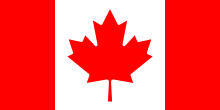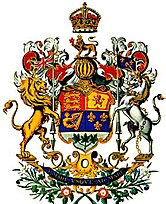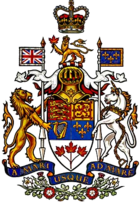National colours of Canada
| Part of a series on the |
| Culture of Canada |
|---|
The national colours of Canada (Template:Lang-fr) were declared by King George V in 1921 to be red and white[1] and are most prominently evident on the country's national flag. Red is symbolic of England and white of France, the colours having been used representatively by those countries in the past.[2] The maple is one of the national symbols and red is the first leaf colour after spring budding & also the autumn colour of maple leaves.[3]
History
Canada's national colours can trace their history to the First Crusade of the 11th century, during which Norman nobleman Bohemond I of Antioch distributed red crosses to the crusaders he led, so that they could affix them to their clothing "as a distinguishing mark".[1] Thereafter, nations were identified by the colour of their cross, and in particular, England used a white cross on a red background and France a red cross on white.[1] Eventually, France and England agreed to exchange their colours[citation needed], and St George's Cross was adopted as an emblem of England. This was the flag used by John Cabot when he landed on the island of Newfoundland on his second voyage in 1497 under the commission of Henry VII of England.[4] The two nations would eventually explore North America, where each claimed territory.
As a result of the proclamation of the Arms of Canada by King George V on 21 November 1921, red and white became Canada's official colours.[1] The proclamation stated "a Royal helmet mantled argent doubled gules" and "a wreath of the colours argent and gules",[3] in which argent refers to the colour white or silver, and gules to red, tinctures used to emblazon a coat of arms.[5] In 1957, the Arms of Canada were modified—the maple leaves on the shield were changed from green to red "in recognition of Canada's official colours".[2] The proclamation accepts both colours for the maple leaves, stating "three maple leaves conjoined on one stem proper",[3] in which "proper" refers to the natural colour of the leaves, which is green in spring and summer, and red in autumn.
It was not until 1961, with the creation of The Queen's Personal Canadian Flag, that red and white became entrenched as the national colours.[6]
Reproduction
For the Federal Identity Program operated by the Treasury Board Secretariat of the Government of Canada, official and signage colours are specified in technical specification T-145.[7]
The red colour is named FIP red and represented by the hexadecimal triplet FF0000, the 8-bit per channel RGB value (255,0,0), the CMYK color (0,100,100,0), or the Pantone Color Matching System colour Pantone 032.[7][8]
A second red colour, known as safety red, is also specified but not used for official symbols; it is represented by the hexadecimal triplet E8112D, RGB value (230,15,45), CMYK colour (0,90,75,0), or Pantone colour 185.[7]
White is represented by CMYK colour white, and the de facto national colour black is represented as CMYK colour black; six more colours are defined for use by the government.[7]
Uses
National flag of Canada

The national flag uses the national colours.[1] Its red-white-red pattern is derived from the flag of the Royal Military College of Canada[9] and the Canada General Service Medal of 1899.[1]
Federal government branding
The national colours are used in federal government branding as part of the Federal Identity Program. This includes the use of the Canadian flag in the Canada wordmark, the "global identifier of the Government of Canada" specified in technical specification T-130.[10]
Decorations
The Canadian Forces Decoration ribbon consists of four red bars separated by equally spaced thin white lines.[11] The Canada Medal instituted on 14 October 1943 was specified to have a ribbon in the national colours,[5] which was the same ribbon used for the Canada General Service Medal.[12] The ill-fated medal was never awarded, and was abolished in 1966 with the introduction of the Order of Canada,[13] which also has a red and white ribbon.
Sport
The Toronto Blue Jays, a franchise in Major League Baseball, honour Canada Day by wearing an alternate jersey instead of the team's usual uniform.[14] In the 1990s, the team would wear red baseball caps,[15] or a red uniform.[16] In 2012, the team wore a red uniform with white lettering.[17]
The Canadian national colours, and the de facto third colour black, are used prominently by ice hockey teams representing the nation, including the men's ice hockey team, men's junior ice hockey team, men's under-18 ice hockey team, men's ice sledge hockey team, men's inline hockey team, women's ice hockey team, and women's under-18 ice hockey team. The logo of Hockey Canada, the national governing body for ice hockey in Canada, is red, white, and black, though their specifications are different from those of the national colours.[18]
See also
Notes
- ^ a b c d e f Canadian Heritage:Official symbols of Canada 2009.
- ^ a b Canadian Heritage: National Colours - Red and White 2009.
- ^ a b c Canadian Heritage: The arms of Canada 2009.
- ^ Canadian Heritage: You were asking... 2009.
- ^ a b McCreery 2005, p. 73.
- ^ Tidridge 2011, p. 222.
- ^ a b c d Treasury Board of Canada Secretariat: Colour Values 2012.
- ^ Industry Canada 2009.
- ^ Montgomery 2013.
- ^ Treasury Board of Canada Secretariat: Canada Wordmark 2012.
- ^ Department of National Defence 2004.
- ^ Veterans Affairs Canada 2013.
- ^ McCreery 2008.
- ^ Creamer.
- ^ CNN Sports Illustrated 1999.
- ^ Creamer 2005.
- ^ Creamer 2012.
- ^ Hockey Canada.
References
- Cochrane, John; Elliott, Stuart (1998). Military Aircraft Insignia of the World. Naval Institute Press. ISBN 1853108731.
- Creamer, Chris (29 September 2005). "1996 Special Event Uniform". Toronto Blue Jays Uniform. Chris Creamer Properties. Retrieved 2013-03-17.
- Creamer, Chris. "Toronto Blue Jays Logos". Chris Creamer Properties. Retrieved 2013-03-17.
- Creamer, Chris (23 June 2012). "Toronto Blue Jays Unveil 2012 Canada Day Jerseys". Chris Creamer Properties. Retrieved 2013-03-17.
- McCreery, Christopher (2005). The Order of Canada: Its origins, history, and development (2 ed.). University of Toronto Press. ISBN 0802039405.
- McCreery, Christopher (19 June 2008). "The Canadian Forces' Decoration". Department of National Defence. Retrieved 2013-03-21.
- Montgomery, Marc (14 February 2013). "Canada's National Flag Day". Retrieved 2013-03-17.
- Tidridge, Nathan (2011). Thompson, Allister (ed.). Canada's Constitutional Monarchy. Dundurn Press. ISBN 9781554889808.
- "Official symbols of Canada". Canadian Heritage. 21 March 2009. Retrieved 2013-03-17.
- "The arms of Canada". Canadian Heritage. 21 March 2009. Retrieved 2013-03-17.
- "You were asking..." Canadian Heritage. 21 March 2009. Archived from the original on 8 June 2011. Retrieved 2013-03-17.
- "National Colours - Red and White". Canadian Heritage. 21 March 2009. Retrieved 2013-03-17.
- "AL Recap (Baltimore-Toronto)". CNN Sports Illustrated. Time Warner. Ticker. 1 July 1999. Retrieved 2013-03-17.
- "Canadian Forces' Decoration (CD)". Canadian Honours Chart. Department of National Defence. 9 November 2004. Retrieved 2013-03-17.
- "Hockey Canada Logo". Hockey Canada. Retrieved 2013-03-17.
- "Government of Canada FIP Signature". Industry Canada. 23 July 2009. Archived from the original on 28 July 2012. Retrieved 2013-03-17.
- "Celebrate Canada Day with Canada's Team". MLB Advanced Media. 30 June 2009. Retrieved 2013-03-17.
- "Colour Values". Treasury Board of Canada Secretariat. 10 May 2012. Retrieved 2013-03-17.
- "Canada Wordmark". Treasury Board of Canada Secretariat. 10 May 2012. Retrieved 2013-03-17.
- "War Medals (1866-1918) - Canada General Service Medal (1866-1870)". Veterans Affairs Canada. 17 January 2013. Retrieved 2013-03-21.
External links
- Canada's National Symbols - excerpt from The Flags of Canada by Alistair B. Fraser



